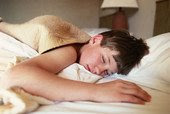
Brain oxygen levels and blood pressure may play a role in the complex relationship between sleep-disordered breathing (SDB) and cognitive problems in children, a U.S. study finds.
About two-thirds of children with SDB (snoring or obstructive sleep apnea) have some degree of cognitive deficit, but it’s been difficult to match the severity of cognitive deficit to the severity of the SDB. This suggests that other factors may be involved or that the correct factors weren’t being measured, according to background information in an American Thoracic Society news release about the study.
“A history of snoring is a predictor for cognitive deficit in children with SDB,” study principal investigator Dr. Raouf Amin, a professor of pediatrics and director of the division of pulmonary medicine at Cincinnati Children’s Hospital Medical Center, said in the news release.
“However, the frequency of apnea events during sleep does not predict cognitive deficit and does not correlate with the degree of cognitive deficit. Such a paradox raised the question of whether there are some variables that we do not traditionally measure in the sleep laboratory that might modify the effect of SDB on cognition,” Amin said.
For this study, which included children aged 7 to 13, the researchers used infrared spectroscopy to determine whether a new factor — the degree to which the brain’s blood remains oxygenated during sleep — could explain variability in cognitive dysfunction better than SDB severity. The children’s blood pressure was also measured.
The results showed that children with snoring had lower regional cerebral oxygen concentration than healthy children. However, children with sleep apnea (usually considered a more severe type of SDB) had higher regional cerebral oxygen concentration than children with just snoring.
“During normal sleep, when breathing appears to be stable, there seems to be higher oxygen in the brain among children with sleep apnea compared even to normal children,” Amin said. “Children with sleep apnea have higher [blood pressure] compared to children with snoring. This may explain why, paradoxically, we find higher oxygen levels in children with [obstructive sleep apnea].”
“By taking into account the role of blood pressure in regulating the amount of oxygen concentration in the brain, we might have a better understanding of the relationship between sleep-disordered breathing and cognitive deficit,” said Amin, who added that this research may prove important in future prevention and treatment efforts.
The study was published in the first issue for November of the American Journal of Respiratory and Critical Care Medicine.
